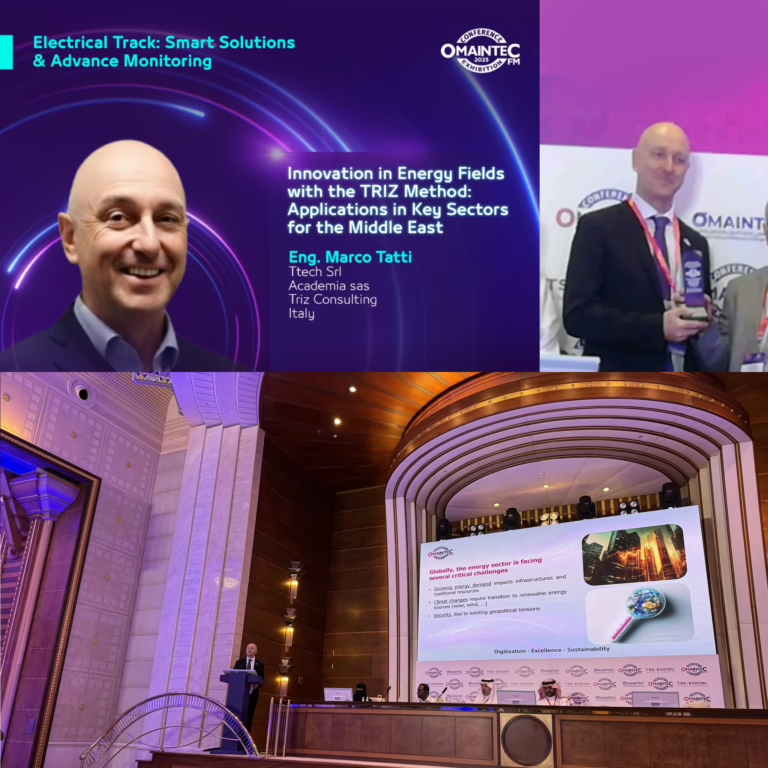During the Obiettivo50 knowledge session, TRIZConsulting.it showcased how the combination of the Theory of Inventive Problem Solving (TRIZ) and Generative Artificial Intelligence (GenAI) can provide a strategic approach to addressing the challenges of digital transformation. TRIZConsulting.it emphasized that, in order to remain competitive, companies must adopt systems capable of generating, analyzing, and implementing effective solutions, rather than relying solely on creative intuition.
What is TRIZ?
Developed in the 1940s by Russian researcher Genrich Altshuller, TRIZ is a methodology based on the analysis of millions of patents, structured to identify recurring patterns in solving complex problems. Utilizing various tools, including the 40 Inventive Principles and Contradiction Analysis, it allows for the identification of innovative solutions that can be adapted and replicated across numerous business contexts. TRIZ is not just a problem-solving tool but a true scientific approach that leverages already tested and validated solutions, applying them across industries from aerospace to consumer electronics, manufacturing, and services. This method significantly improves decision-making processes and productivity. The strength of TRIZ lies in its adaptability: many solutions already exist, at least structurally, and can therefore be reused in new contexts. This characteristic makes TRIZ a valuable system for companies seeking systematic, rather than purely creative, innovation.
Simultaneously, GenAI has made enormous strides, evolving from procedural models and solutions like neural networks to structured and complex systems such as Generative Artificial Intelligence. By 2028, the global AI market is expected to reach 6 trillion US dollars (McKinsey 2024), making it an essential factor for any company aiming to remain competitive. AI integration into business processes enables the analysis of large volumes of data, identifying patterns that enhance operational efficiency.
How GenAI Supports TRIZ
The integration of GenAI into the TRIZ process makes the latter even more efficient, reducing action times and thus speeding up the generation and evaluation of innovative ideas. Thanks to its ability to process large amounts of data, GenAI can analyze relevant patents and suggest solutions with greater precision. Through techniques such as Natural Language Processing (NLP), GenAI can also transform complex problems into standardized models, making them easier to solve.
This synergy allows companies to access a vast repository of knowledge and accelerate the development of innovative solutions, increasing productivity and addressing business challenges more effectively.
Case Study: Optimizing a Café with TRIZ and GenAI
During the session, TRIZConsulting.it presented a practical case of applying TRIZ and GenAI in a café facing customer flow management issues. Long waits during peak hours and a drop in clientele after 2:00 PM posed significant problems for the business.
Through the application of TRIZ + GenAI, solutions such as a self-service logic, the creation of flexible, quickly reorganizable spaces, and an online reservation system to better manage customer flow were suggested in just a few moments. The system also allowed for the analysis of customer behavior data, proposing strategies like early reservations (incentivized with small discounts for services offered outside peak hours) and highly targeted marketing initiatives to increase the café’s profitability during typically less busy times. This simple example highlights how TRIZ and GenAI can be immediate and effective tools, especially for SMEs, in practical and everyday contexts.
The Value of TRIZ and GenAI for SMEs
SMEs, which make up the majority of European businesses, can significantly benefit from the integration of TRIZ and GenAI. However, many companies do not fully exploit the potential of these tools, which can reduce costs, accelerate development times, and improve customer experience, while also optimizing internal resource management. TRIZ has provided a proven approach to tackling complex problems for nearly a century, while GenAI adds an additional layer of efficiency with its ability to process large amounts of data and identify innovative solutions in a very short time. Together, TRIZ and GenAI offer a comprehensive framework for innovation, helping companies prepare for future challenges with a more strategic and data-driven approach.
Conclusions
During the final debate, it became clear that the combination of TRIZ and GenAI represents a powerful resource for business innovation. However, it is equally evident that to fully benefit from these tools, companies must invest in appropriate training, especially for managers and technicians who will lead their implementation. The adoption of tools like TRIZ and GenAI is not only about technological efficiency but also about the ability to solve complex problems in a more structured and systematic way. Companies that want to innovate must focus not only on technology but also on the skills needed to use it effectively and strategically.







